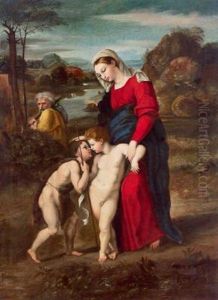Raffaello De'Carli Del Garbo Paintings
Raffaello de' Carli, commonly known as Raffaellino del Garbo, was an Italian Renaissance painter active primarily in Florence. Born circa 1466 in Florence, Italy, del Garbo trained under the prominent early Renaissance painter Filippino Lippi, whose influence is evident in Raffaellino's graceful figures and vibrant use of color. He was also influenced by other contemporary Florentine masters such as Sandro Botticelli and Domenico Ghirlandaio.
Raffaellino del Garbo's career flourished in the late 15th and early 16th centuries, a period marked by the patronage of the powerful Medici family and a general flourishing of the arts in Florence. His work includes religious panel paintings, frescoes, and altarpieces that reflect the typical Florentine style of the time, characterized by a balanced composition, clarity of form, and a focus on narrative detail. Among his known works are 'The Annunciation' (circa 1500) for San Gallo in Florence and 'The Coronation of the Virgin' (circa 1504) for the high altar of San Marco in Florence.
Raffaellino's paintings often depicted scenes from the life of Christ, the Virgin Mary, and the saints, executed with a delicate sensibility and an attention to emotional expression. His figures are noted for their elegance and for the artist's skill in rendering the fabrics and textures of their garments.
Despite his considerable skill, Raffaellino del Garbo did not achieve the same level of fame as some of his contemporaries. However, his work has been appreciated for its contribution to the development of Florentine painting during a time of great artistic achievement. Unfortunately, documentation about del Garbo's life is scarce, and many aspects of his biography remain shrouded in mystery.
Raffaellino del Garbo's career declined towards the end of his life, and he faced financial difficulties. He died in 1524 in Florence, and his passing marked the end of an artistic career that, while not as celebrated as some, contributed to the rich tapestry of Renaissance art. His works can still be seen in various museums and churches in Italy, where they continue to be studied and admired for their beauty and historical significance.




